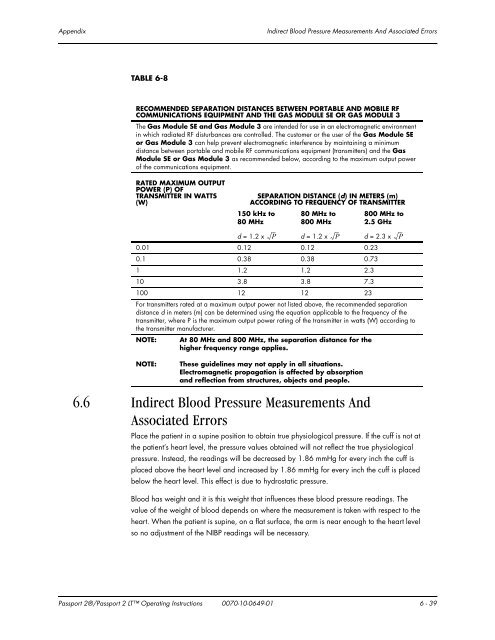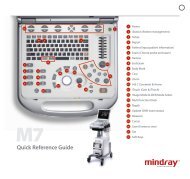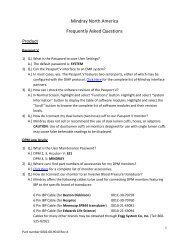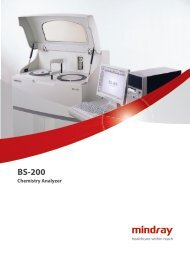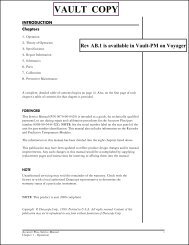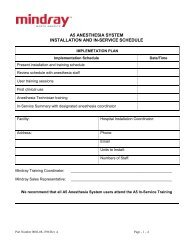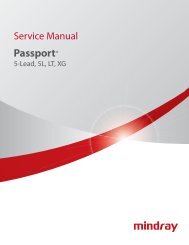Datascope Passport - Mindray
Datascope Passport - Mindray
Datascope Passport - Mindray
You also want an ePaper? Increase the reach of your titles
YUMPU automatically turns print PDFs into web optimized ePapers that Google loves.
Appendix Indirect Blood Pressure Measurements And Associated Errors<br />
TABLE 6-8<br />
RECOMMENDED SEPARATION DISTANCES BETWEEN PORTABLE AND MOBILE RF<br />
COMMUNICATIONS EQUIPMENT AND THE GAS MODULE SE OR GAS MODULE 3<br />
The Gas Module SE and Gas Module 3 are intended for use in an electromagnetic environment<br />
in which radiated RF disturbances are controlled. The customer or the user of the Gas Module SE<br />
or Gas Module 3 can help prevent electromagnetic interference by maintaining a minimum<br />
distance between portable and mobile RF communications equipment (transmitters) and the Gas<br />
Module SE or Gas Module 3 as recommended below, according to the maximum output power<br />
of the communications equipment.<br />
RATED MAXIMUM OUTPUT<br />
POWER (P) OF<br />
TRANSMITTER IN WATTS<br />
(W)<br />
SEPARATION DISTANCE (d) IN METERS (m)<br />
ACCORDING TO FREQUENCY OF TRANSMITTER<br />
150 kHz to<br />
80 MHz<br />
80 MHz to<br />
800 MHz<br />
d = 1.2 x P d = 1.2 x P d = 2.3 x P<br />
0.01 0.12 0.12 0.23<br />
0.1 0.38 0.38 0.73<br />
1 1.2 1.2 2.3<br />
10 3.8 3.8 7.3<br />
100 12 12 23<br />
For transmitters rated at a maximum output power not listed above, the recommended separation<br />
distance d in meters (m) can be determined using the equation applicable to the frequency of the<br />
transmitter, where P is the maximum output power rating of the transmitter in watts (W) according to<br />
the transmitter manufacturer.<br />
NOTE: At 80 MHz and 800 MHz, the separation distance for the<br />
higher frequency range applies.<br />
NOTE: These guidelines may not apply in all situations.<br />
Electromagnetic propagation is affected by absorption<br />
and reflection from structures, objects and people.<br />
6.6 Indirect Blood Pressure Measurements And<br />
Associated Errors<br />
800 MHz to<br />
2.5 GHz<br />
Place the patient in a supine position to obtain true physiological pressure. If the cuff is not at<br />
the patient’s heart level, the pressure values obtained will not reflect the true physiological<br />
pressure. Instead, the readings will be decreased by 1.86 mmHg for every inch the cuff is<br />
placed above the heart level and increased by 1.86 mmHg for every inch the cuff is placed<br />
below the heart level. This effect is due to hydrostatic pressure.<br />
Blood has weight and it is this weight that influences these blood pressure readings. The<br />
value of the weight of blood depends on where the measurement is taken with respect to the<br />
heart. When the patient is supine, on a flat surface, the arm is near enough to the heart level<br />
so no adjustment of the NIBP readings will be necessary.<br />
<strong>Passport</strong> 2®/<strong>Passport</strong> 2 LT Operating Instructions 0070-10-0649-01 6 - 39


